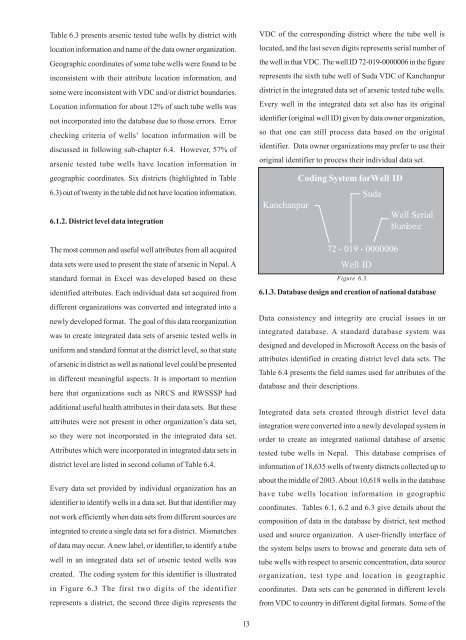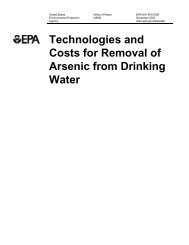The State of Arsenic in Nepal - 2003 - Harvard University ...
The State of Arsenic in Nepal - 2003 - Harvard University ...
The State of Arsenic in Nepal - 2003 - Harvard University ...
You also want an ePaper? Increase the reach of your titles
YUMPU automatically turns print PDFs into web optimized ePapers that Google loves.
Table 6.3 presents arsenic tested tube wells by district with<br />
location <strong>in</strong>formation and name <strong>of</strong> the data owner organization.<br />
Geographic coord<strong>in</strong>ates <strong>of</strong> some tube wells were found to be<br />
<strong>in</strong>consistent with their attribute location <strong>in</strong>formation, and<br />
some were <strong>in</strong>consistent with VDC and/or district boundaries.<br />
Location <strong>in</strong>formation for about 12% <strong>of</strong> such tube wells was<br />
not <strong>in</strong>corporated <strong>in</strong>to the database due to those errors. Error<br />
check<strong>in</strong>g criteria <strong>of</strong> wells’ location <strong>in</strong>formation will be<br />
discussed <strong>in</strong> follow<strong>in</strong>g sub-chapter 6.4. However, 57% <strong>of</strong><br />
arsenic tested tube wells have location <strong>in</strong>formation <strong>in</strong><br />
geographic coord<strong>in</strong>ates. Six districts (highlighted <strong>in</strong> Table<br />
6.3) out <strong>of</strong> twenty <strong>in</strong> the table did not have location <strong>in</strong>formation.<br />
6.1.2. District level data <strong>in</strong>tegration<br />
<strong>The</strong> most common and useful well attributes from all acquired<br />
data sets were used to present the state <strong>of</strong> arsenic <strong>in</strong> <strong>Nepal</strong>. A<br />
standard format <strong>in</strong> Excel was developed based on these<br />
identified attributes. Each <strong>in</strong>dividual data set acquired from<br />
different organizations was converted and <strong>in</strong>tegrated <strong>in</strong>to a<br />
newly developed format. <strong>The</strong> goal <strong>of</strong> this data reorganization<br />
was to create <strong>in</strong>tegrated data sets <strong>of</strong> arsenic tested wells <strong>in</strong><br />
uniform and standard format at the district level, so that state<br />
<strong>of</strong> arsenic <strong>in</strong> district as well as national level could be presented<br />
<strong>in</strong> different mean<strong>in</strong>gful aspects. It is important to mention<br />
here that organizations such as NRCS and RWSSSP had<br />
additional useful health attributes <strong>in</strong> their data sets. But these<br />
attributes were not present <strong>in</strong> other organization’s data set,<br />
so they were not <strong>in</strong>corporated <strong>in</strong> the <strong>in</strong>tegrated data set.<br />
Attributes which were <strong>in</strong>corporated <strong>in</strong> <strong>in</strong>tegrated data sets <strong>in</strong><br />
district level are listed <strong>in</strong> second column <strong>of</strong> Table 6.4.<br />
Every data set provided by <strong>in</strong>dividual organization has an<br />
identifier to identify wells <strong>in</strong> a data set. But that identifier may<br />
not work efficiently when data sets from different sources are<br />
<strong>in</strong>tegrated to create a s<strong>in</strong>gle data set for a district. Mismatches<br />
<strong>of</strong> data may occur. A new label, or identifier, to identify a tube<br />
well <strong>in</strong> an <strong>in</strong>tegrated data set <strong>of</strong> arsenic tested wells was<br />
created. <strong>The</strong> cod<strong>in</strong>g system for this identifier is illustrated<br />
<strong>in</strong> Figure 6.3 <strong>The</strong> first two digits <strong>of</strong> the identifier<br />
represents a district, the second three digits represents the<br />
VDC <strong>of</strong> the correspond<strong>in</strong>g district where the tube well is<br />
located, and the last seven digits represents serial number <strong>of</strong><br />
the well <strong>in</strong> that VDC. <strong>The</strong> well ID 72-019-0000006 <strong>in</strong> the figure<br />
represents the sixth tube well <strong>of</strong> Suda VDC <strong>of</strong> Kanchanpur<br />
district <strong>in</strong> the <strong>in</strong>tegrated data set <strong>of</strong> arsenic tested tube wells.<br />
Every well <strong>in</strong> the <strong>in</strong>tegrated data set also has its orig<strong>in</strong>al<br />
identifier (orig<strong>in</strong>al well ID) given by data owner organization,<br />
so that one can still process data based on the orig<strong>in</strong>al<br />
identifier. Data owner organizations may prefer to use their<br />
orig<strong>in</strong>al identifier to process their <strong>in</strong>dividual data set.<br />
Kanchanpur<br />
Cod<strong>in</strong>g System forWell ID<br />
Figure 6.3.<br />
6.1.3. Database design and creation <strong>of</strong> national database<br />
Data consistency and <strong>in</strong>tegrity are crucial issues <strong>in</strong> an<br />
<strong>in</strong>tegrated database. A standard database system was<br />
designed and developed <strong>in</strong> Micros<strong>of</strong>t Access on the basis <strong>of</strong><br />
attributes identified <strong>in</strong> creat<strong>in</strong>g district level data sets. <strong>The</strong><br />
Table 6.4 presents the field names used for attributes <strong>of</strong> the<br />
database and their descriptions.<br />
Suda<br />
72 - 019 - 0000006<br />
Well ID<br />
Well Serial<br />
Number<br />
Integrated data sets created through district level data<br />
<strong>in</strong>tegration were converted <strong>in</strong>to a newly developed system <strong>in</strong><br />
order to create an <strong>in</strong>tegrated national database <strong>of</strong> arsenic<br />
tested tube wells <strong>in</strong> <strong>Nepal</strong>. This database comprises <strong>of</strong><br />
<strong>in</strong>formation <strong>of</strong> 18,635 wells <strong>of</strong> twenty districts collected up to<br />
about the middle <strong>of</strong> <strong>2003</strong>. About 10,618 wells <strong>in</strong> the database<br />
have tube wells location <strong>in</strong>formation <strong>in</strong> geographic<br />
coord<strong>in</strong>ates. Tables 6.1, 6.2 and 6.3 give details about the<br />
composition <strong>of</strong> data <strong>in</strong> the database by district, test method<br />
used and source organization. A user-friendly <strong>in</strong>terface <strong>of</strong><br />
the system helps users to browse and generate data sets <strong>of</strong><br />
tube wells with respect to arsenic concentration, data source<br />
organization, test type and location <strong>in</strong> geographic<br />
coord<strong>in</strong>ates. Data sets can be generated <strong>in</strong> different levels<br />
from VDC to country <strong>in</strong> different digital formats. Some <strong>of</strong> the<br />
13

















